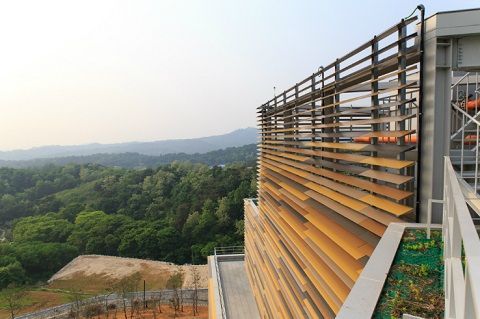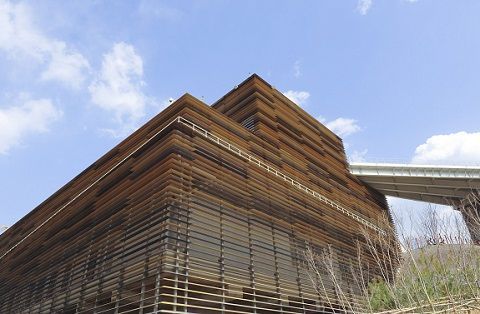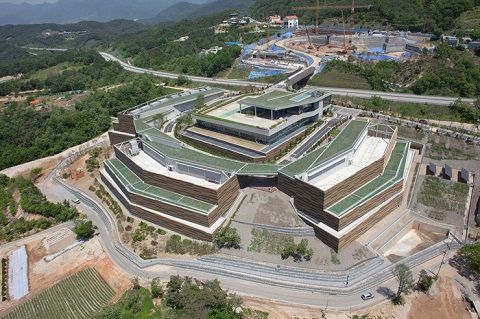Kengo Kuma, the famous Japanese architect and the author of ‘Natural Architecture’, was inspired by Janggyeong Panjeon or Janggyeonggak in Haeinsa Temple which houses the Tripitaka Koreana, and designed this building.
He didn’t just take notes from the looks of Janggyeong Panjeon. He also took notice of the fact that it was a building for preserving records, and named his new building ‘Gak’. On the 20th, NHN revealed to the press the first Internet Data Center for a domestic Internet corporation, ‘Gak’.
| |
| ▲ The exteriors of NHN’s data center, ‘Gak’. Famous Japanese architect Kuma Kengo got the motive for this design from Janggyeong Panjeon in Haeinsa Temple which houses the Triptaka Koreana. |
| |
| ▲ The wood-colored louvers that cover the exterior walls have been built with optimum angles for the light and wind to come in and go out. |
Gak is located on the skirt of Gubong Mountain in Dongmyeon, Chuncheon of Gangwon Province. It covers the area equal to seven soccer fields, and consist of a main building and three server buildings. The buildings are located in multiple levels along the slope of Gubong Mountain. Such design choices were made to let the wind coming from the mountain in the building, and lower the room temperature. The looks of Gak reminded me of terrace tea fields.
The reason why NHN chose Chuncheon as its site out of thirty candidates is clear. First, there was no damage from natural disasters such as earthquakes or yellow dust during the last thirty years in Chuncheon. Second, the annual average temperature is 1~2 degrees(Celsius) lower than the metropolitan area of Seoul, where many Internet data centers are located. Thus the IDC can be cooled naturally and conserve more energy. Third, with abundance of natural resources like those from the Soyang Dam, the IDC can refill the 800 tons of water that evaporate every day in the center. Plus the site is highly accessible from the metropolitan area. There couldn’t be a better place to build an IDC.
| |
| ▲ Gak is about the size of seven soccer fields. It consists of four buildings: one main building and three server buildings. The buildings are built in multiple levels along the slope of Gubong Mountain. It is designed for easy extension. |
The buildings can house 90,000 servers. Inside the data center, there is a lot of high-tech equipment: servers that can withstand temperatures up to 35 degrees Celsius, energy efficient/high density racks that support up to 51 servers, a shielding system that prevents hot and cold air from mixing with each other to prevent thermal loss, etc.
The server rooms’ air misting units that have been under R&D for about a year have been applied to the building. These units will help the servers to hold up during the long, hot and humid summers in Korea. The building is the first IDC in the world to receive a platinum rating, the highest rating possible, from LEED, an internationally accepted green certification system. The building also boasts a 1.11 PUE which is about half the global average of 2.0. (PUE is the measure used to evaluate the energy efficiency of IDCs.)
Gak was designed to endure earthquakes of up to 9.0 magnitude, as well as floods, storms, fires and other natural disasters. In case the external electricity supply is cut off, the center has equipment called ‘Dynamic UPS’ that will provide up to 72 hours of electricity. This is the same amount of electricity that 16 oil tankers would provide.
| |
| ▲ NHN workers maintaining the Dynamic UPS equipment of ‘Gak’. This equipment can supply electricity within 2.5 seconds of a power outage, and maintain the supply for up to 72 hours. |
Korea’s first digital record preservation center
Global companies such as Google and Facebook already have IDCs up and running, but for a domestic Internet company, the construction of its independent IDC is a first. The establishment of ‘Gak’ reflects NHN Chairman Lee Hae-Jin’s strong will to safely preserve the data of Naver users and pass them down to the next generation.
Head of NHN’s IT Service Headquarters Park Won-Ki stated, “As the amount of data we receive that contain the personal lives of Naver users is increasing, we felt a sense of duty to store the digital records safely, and that is why we built Gak.”
Over the past ten years Naver users created 180 petabytes worth of data. Today, 4000 searches are being done every second and 2300 emails are coming and going on Naver. More than 20 million photos are uploaded everyday on N-Drive, equivalent to about 400TB.
| |
| ▲ Naver users have created 180PB of data in the past ten years. . Today, 4000 searches are being done every second and 2300 emails are coming and going. Photo above shows the server room where the data is store. |
The server room in the IDC is where all this information is gathered. Blog posts, attached files on emails, messages sent through NHN’s mobile messenger, Line, all come to this room first. NHN then removes overlapping information, compresses the data, and copies the rest to external IDCs.
“In the current day and age international companies come in to foreign countries and threaten the existence of domestic services. The fact that a domestic Internet company has established its own IDC, means that we have built a foundation to preserve the digital assets written in Korean,” Mr. Park quoted. NHN plans to expand the IDC as more data stacks up.




